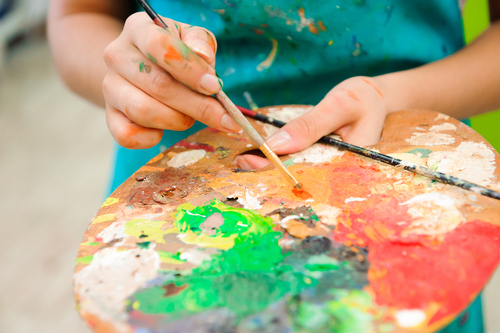
Prior to delving into the benefits of art therapy it is helpful to gain a basic understanding of what exactly art therapy is and how it came about. As is defined by the American Art Therapy Association art therapy is “an integrative mental health and human services profession that enriches the lives of individuals, families, and communities through active art-making, creative process, applied psychological theory, and human experience within a psychotherapeutic relationship.” Art therapists are trained mental health clinicians that are educated in human development, clinical practice, psychological theories, and fine art. Art therapy sessions can be conducted in an individual or group setting. Art therapy can be used on its own or in conjunction with other therapeutic treatment modalities. British artist, Adrian Hill, coined the term ‘art therapy’ in 1942 after discovering the healthful benefits of drawing and painting while recovering from tuberculosis. Art therapy encourages participants to explore self-expression, emotions, and challenges through various art media rather than relying on verbal articulation. Art therapy is currently recognized as an effective psychotherapeutic approach that is regularly used by mental health clinicians to treat variety of mental health ailments, spanning across all ages.
Benefits
Art therapy is a therapeutic technique that is rooted in the notion that creativity and creative expression can foster healing and promote mental well-being. Findings from a 2016 study published in the Journal of the American Art Therapy Association, indicate that less than an hour of creative activity can reduce stress and have a positive effect on one’s mental health, regardless of one’s artistic experience or talent. There are many benefits to art therapy:
- It can promote self-expression and self-discovery.
- One review indicated that in patients undergoing medical treatment for cancer, art therapy helped to improve their quality of life and alleviated a variety of psychological symptoms.
- It can be a cathartic release.
- Research found that art therapy increased self-esteem and reduced depression in older adults living in nursing homes.
- The process encourages the development of healthy coping strategies.
- It improves self-esteem and increases resilience.
- Studies of adults who experienced trauma found that art therapy led to decreased levels of depression and significantly reduced trauma symptoms.
- Promotes self-reliance, personal independence, and self-sufficiency.
- It enables individuals to verbally and nonverbally communicate emotions that may otherwise be abandoned.
Art therapy can benefit anyone, especially those that are artistically inclined and/ or those that may be uncomfortable with their ability to accurately articulate their emotions. However, it is important to bear in mind that every person is unique and different treatment modalities will resonate distinctly with each individual.
Disclaimer:
The information above is provided for the use of informational purposes only. The above content is not to be substituted for professional advice, diagnosis, or treatment, as in no way is it intended as an attempt to practice medicine, give specific medical advice, including, without limitation, advice concerning the topic of mental health. As such, please do not use any material provided above as a means to disregard professional advice or delay seeking treatment.

